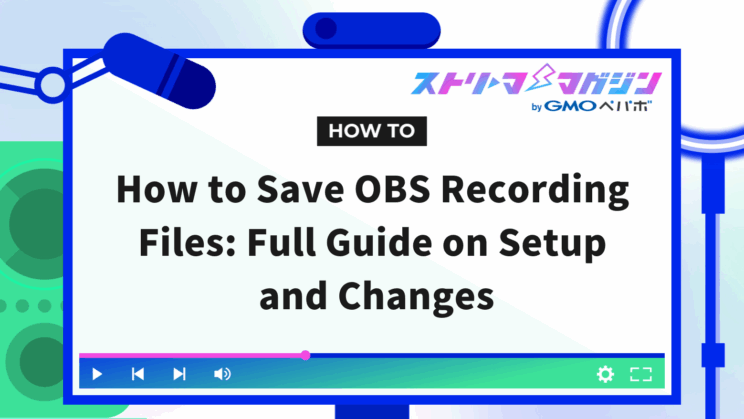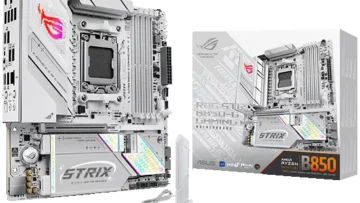How to Save OBS Recording Files: Full Guide on Setup and Changes

Index
- Basic Knowledge to Know Before Recording with OBS
- How to Check the Storage Location for OBS Recordings
- How to Set the Storage Destination for OBS Recordings
- How to Change the Save Location for OBS Recordings
- Recommended Settings That Influence the Quality of OBS Recordings
- How to Record Videos with OBS
- Troubleshooting When Issues Occur with Saving OBS Recordings
- What’s Next After Setting the Save Location for OBS Recording Files?
OBS Studio (hereafter referred to as OBS) is a free software used for live streaming on a computer, primarily used for game streaming and VTuber broadcasts.
The main feature of OBS is live streaming, but it also allows recording of your desktop and game screens. The quality of the recording, both video and audio, can be finely adjusted in the output settings, enabling you to record and save high-quality videos. Mastering the recording feature can also be useful for creating short videos or reviewing your streams.
This article provides a comprehensive guide on how to check, set up, and change the storage destination for videos recorded with OBS, tips for high-quality recording, recording procedures, and solutions for saving-related issues.
Basic Knowledge to Know Before Recording with OBS
Here are two basic pieces of knowledge regarding the storage destination for videos recorded with OBS.
- The default storage destination for OBS recordings is pre-set
- It is recommended to use an SSD rather than an HDD for storing OBS recordings
Default Storage Destination for OBS Recordings
The storage location for videos recorded with OBS is predetermined by default. If the user does not modify the settings, the videos will be saved in the typical storage location on Windows OS, which is the “Videos” folder located at “C:\Users\(PC username)\Videos”.
If you record with OBS without setting a storage destination, first check the above folder to see if the video has been saved there.
Recommendation to Use SSD Instead of HDD for OBS Recording Storage
For storing OBS recordings, it’s better to use a SATA SSD or M.2 SSD with faster write speeds than an HDD. This is because HDDs have slower write speeds compared to SSDs, and if streaming software settings are in high resolution, there is a higher possibility of errors occurring during recording.
Incidentally, it’s fine to use an HDD as a storage location for completed recording data.
If you have no choice but to use an HDD for OBS recording, take the following precautions:
- Set the recording resolution and bitrate to lower settings
- Use a high-speed HDD with a read speed of at least 7,200rpm
If you’re using the C drive as a storage location, ensure there is sufficient free space before saving. Even with a suitable M.2 SSD for OBS storage, performance can degrade significantly if free space falls below 20%.
To ensure smooth recording, remove unnecessary data and cache to keep space free, and migrate unneeded saved data for recording to an external HDD.
How to Check the Storage Location for OBS Recordings
You can check where OBS videos are saved via the File menu on the menu bar. Verifying the storage location for OBS recording files can be done with just two clicks. Here’s how you do it:
- On the menu bar at the top of OBS, click on “File”
- Click “Show Recordings” to verify the storage location of the video files
How to Set the Storage Destination for OBS Recordings
The recording destination for OBS videos is set through the record file path.
Setting the specific file for OBS recordings can be done just by sequentially clicking, similar to checking the storage location of videos. Follow these steps to set the storage destination:
- Click “Settings” located at the bottom of the OBS main screen
- Select “Output”
- Change the output mode to “Advanced” and click on “Recording”
- Click “Browse” next to “Recording Path” to select the storage destination file, then click OK
How to Change the Save Location for OBS Recordings
To change the save location for OBS recordings, start from the “Settings” button. Follow these steps to change the save location:
- Click “Settings” at the bottom of the OBS main screen
- Select “Output”
- Select “Recording”
- Click “Browse” next to “Recording Path,” select the existing save location file or create and select a new folder
Recommended Settings That Influence the Quality of OBS Recordings
Proper pre-configuration is crucial for recording high-quality videos with OBS.
To access detailed recording settings, you can open the “Output” tab from the “Settings” on the bottom right of OBS and switch to “Advanced.”
Here are the recommended recording settings by item.
Among the settings listed above, the video encoder is particularly important.
| Item | Setting |
|---|---|
| Audio Track | Audio track in use |
| Video Encoder | NVIDIA NVENC H.264 or x264 |
| Audio Encoder | FFmpeg AAC |
| Recording Format | MPEG-4 (.mp4) |
| Output Rescaling | Optional |
| Automatic File Splitting | Optional |
| Recording Path | Folder where you want to save |
| Custom Multiplexer Settings | Leave blank |
For smooth high-quality video recording, NVIDIA NVENC H.264, which is suitable for video content and graphics playback based on a compatible GPU (graphics card), is recommended. However, note that the video encoder options vary depending on your PC environment. NVIDIA NVENC H.264 is selectable only if your GPU supports the GTX/RTX series, so if it’s not supported, opt for x264 instead.
Additionally, note that the rate control options for encoder settings differ depending on the video encoder used.
If you use OBS exclusively for recording, avoid using the “Use Streaming Encoder” option, which allows simultaneous streaming and recording.
For more tips on how to record high-quality videos with OBS, check out the article below.
Tips for Recording High-Quality Videos with OBS: Detailed Settings and Key Points
How to Record Videos with OBS
The recording process with OBS can be completed easily by following these four steps:
- Create a scene for recording
- Add a source and display the video you want to record on OBS
- Set the audio settings for the recording video
- Press “Start Recording” to begin
Let’s go through each step in detail.
Create a Scene for Recording
When starting a recording with OBS, begin by adding a scene for recording.
Click the “+” sign located in the bottom left corner of the scene frame on the TOP screen to set a file name for the recording and click “OK” to create a scene.
Add a Source and Display the Video You Want to Record on OBS
After adding a scene, the next step is to add the sources necessary for recording.
Multiple sources are pre-set by default, so click on any unnecessary sources to remove them using the “-” (or trash can icon) and pick out the required sources using the “+” to set your sources.
If you want to add text or images to the capture screen, you can also do so using the “+” button. For more detailed source configurations, use the gear icon.
Below are four typical sources; select the ones you need accordingly.
| Source Name | Feature |
|---|---|
| Display Capture | Displays the entire screen on OBS, reflecting what is shown on the desktop screen |
| Game Capture | Displays PC game screens on OBS, used for game commentary recordings |
| Window Capture | Displays browser screens on OBS, showing only the selected window |
| Video Capture Device | Displays game screens from gaming consoles on OBS; requires an additional device to capture Switch/PS4/PS5 images on OBS |
Once the source is added, display the video you want to record on OBS.
Set the Audio Settings for the Recording Video
After adding the scenes and sources, set the audio settings for OBS recording.
The method for adding audio to videos depends on whether you select desktop audio, mic audio, or specific audio; each requires different settings. Refer to the details below for configuring audio settings:
| Type of Audio | How to Add Audio |
|---|---|
| Desktop Audio | Click in sequence “File” → “Settings” → “Audio”, set Desktop Audio to “Default” and click “OK”, then check if the audio mixer responds by playing music on the desktop |
| Mic Audio | Click “File” → “Settings” → “Audio”, select the mic used for Mic Audio and click “OK”, then verify mic functionality by talking into the mic and checking if the audio mixer responds |
| Specific Audio *for OBS version 28.0 or later | Set Desktop Audio to “Disabled” by navigating through “File” → “Settings” → “Audio”, then click “Application Audio Capture” in the “+” under sources, select the audio you want to broadcast in the setup screen and confirm if the audio mixer responds, also ensure unwanted audio does not activate the mixer |
Press “Start Recording” to Begin
Pressing “Start Recording” initiates the recording, lighting up a red “REC” sign at the bottom right with a timer counting the recording time.
To stop the recording, simply press “Stop Recording,” making both starting and stopping easy.
For a detailed guide on how to record your screen and beginner-friendly setup tips, be sure to check out the article below.
How to Record Your Screen with OBS Studio: A Step-by-Step Guide with Simple Settings for Beginners
Troubleshooting When Issues Occur with Saving OBS Recordings
Knowing the solutions to issues related to saving OBS recordings provides peace of mind. Here are ways to address two common problems:
- When the recording file is not saved
- When you accidentally delete a recording file
When the Recording File Is Not Saved
If the recording file is not saved, first try restarting OBS. Restarting the system can clear temporary glitches, potentially allowing the file to save properly.
If your OBS version is outdated, consider upgrading to a newer version as well. You can verify update information by selecting “Help” from the top of the OBS screen and clicking “Check For Updates.”
If an update is needed, proceed with the upgrade.
When You Accidentally Delete a Recording File
If you accidentally delete a recording file, first check the following methods to see if you can restore the file:
- Check the Trash
- Restore the file from its history
- Use Time Machine (Mac)
- Revert the whole system to an earlier time to restore the file (Windows)
If these methods fail to restore your video file, try using ‘iMyFone D-Back for PC’ to recover the file. ‘iMyFone D-Back for PC’ is highly reliable and capable of supporting various file format recoveries, including video formats such as “.flv” and “.mp4”. It operates smoothly on both Windows and Mac, making it accessible to use.
For more troubleshooting tips related to OBS, take a look at the following articles.
No Sound in OBS? Easy Fixes for Each Audio Issue
Microphone Not Working in OBS? Possible Causes and How to Fix Them
Fix Choppy OBS Recordings Now! A Complete Guide to Causes and Solutions
What’s Next After Setting the Save Location for OBS Recording Files?
This time, we’ve provided a thorough explanation on how to verify, change, and set the storage location for OBS recording files. While OBS has a default save location, setting your preferred location before you start recording will help you manage files smoothly.
The quality of the recording can greatly change based on the settings used, so alongside checking the storage destination, it’s vital to review and optimize your recording settings. Thorough preparation beforehand will ensure smooth broadcasting and video editing.
Once you’ve set up your recording environment, why not focus on enhancing your streaming presentation?
With “Alive Studio“, you can significantly upgrade the quality of your streams!
- Gain access to over 1,000 background and accessory materials from the VTuber support team “Usaneko Memory”!
- Enjoy over 100 royalty-free BGM tracks provided by the music material site “Maoudamashii”!
- Features like theme roulette and counter functionality included!
- All features available for just ¥980 per month (including tax)!
If you want to focus not only on recording but also on the visuals and presentation of your stream, be sure to try “Alive Studio“!
\ Start with a Free 7-Day Trial and Take Your Streaming to the Next Level! /








